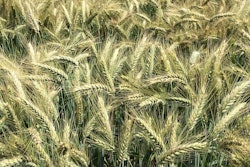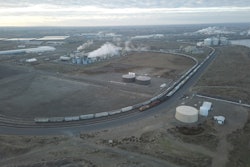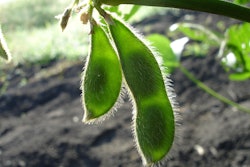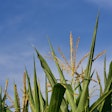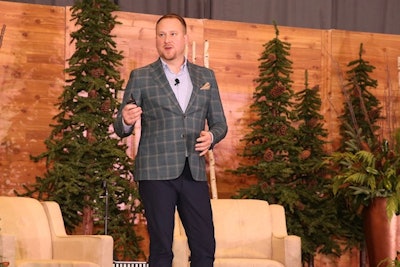
Jake Joraanstad, CEO & co-founder of Bushel, said artificial intelligence (AI) is the most important technology of the 21st Century during the closing session of the National Grain and Feed Association’s (NGFA) Country Elevator Conference, held December 3-5 in Louisville, Kentucky.
His presentation, “Is it Scary or a Saving Grace? Generative AI and Real Talk on How it Could Impact Agriculture and Agribusinesses,” examined AI’s historical significance and practical ways agribusinesses can use it to enhance productivity today.
AI is not a fad
The introduction of AI is as critical an event as the creation of the internet, Joraanstad said. Other emerging technologies since the dawn of the internet have promised to revolutionize agriculture but failed to become as disruptive as AI is. Blockchain, for example, was predicted to become the new standard for agricultural purchase transaction logs but hasn’t meaningfully impacted supply chains yet due to its limited adaptation.
“AI is not that,” Joraanstad said. “This is not a fad. This is not some interesting tool — although it is that, as well — this is going to change how the typical human being on Earth operates, especially in our offices and at any desk job."
The key difference between AI and other technologies is accessibility, he said. The ease and speed at which anyone can begin using AI, compared to innovations like the autonomous vehicle, is a monumental factor. Where barriers like safety concerns, initial costs and public acceptance hinder autonomous vehicle purchases, AI tools can be downloaded for free or inexpensively and operate on devices that users already own. Its versatility is another reason AI has been widely accepted so quickly.
Joraanstad acknowledged how AI’s rapid evolution may cause society to fear it but encouraged attendees to use AI to their advantage rather than dismiss the value of this breakthrough technology.
“Our brains have a hard time comprehending how fast [AI] is changing,” he said. “Even the people developing AI right now are somewhat afraid and a bit confused as to why things are working so well. That is a bit scary, but I'm hoping I'll convince you that we need to use these tools in our industry to serve our industry. Don't bury your head in the sand.”
Practical applications for AI
Joraanstad advised agribusinesses and their employees to begin testing with Narrow AI as soon as possible. Examples of Narrow AI include voice generators, facial recognition tools, image generators and conversational bots, like Chat GPT-3 and GPT-4.
Using these tools is as simple as having a conversation. Users send bots inquiries via chat and receive an answer almost immediately. Answers may require refinement or follow-up queries to get a suitable response and Joraanstad stressed the importance of writing specific queries with as much detail as possible to improve the quality of the responses.
AI can help boost agribusiness productivity across many job functions. For example, it can be asked to write market commentary and press releases, generate ideas for logos, generate and format spreadsheets, write computer program code and create business presentations.
However, Joraanstad cautioned against providing AI with confidential information or intellectual property, especially with free models that can expose the information users provide to it elsewhere.
Another best practice is to proofread and fact-check all AI-generated content before presenting or publishing it, as AI is not error-proof, Joraanstad said.
AI models continue to improve their accuracy and are rapidly becoming smarter. Joraanstad said recent progress in satellite imagery could one day enhance crop yield efficiency using AI.
“The recognition of patterns in our soil and conditions in the crops will have a big impact,” Joraanstad said. “There are thousands of imagery companies sourcing images mainly for free from the government, as well as from smaller satellites. The way AI processes information is fundamentally changing as we speak, and is getting better at understanding what red, yellow or green indicates on a map so it can offer insights. You can expect in the next few years to have better imagery outcomes and a better understanding of what's happening in your region.”
Agribusinesses should view AI as a means to accomplish more with less and begin AI pilot programs to identify which applications offer the most value for their employees and customers. Following AI best practices and staying informed on new developments in the AI space will help agribusinesses optimize these powerful tools and advance their businesses along with the technology.
Jake Joraanstad is the CEO & co-founder of Bushel, a company he co-founded in 2011 as Myriad Mobile. Bushel, specializing in agricultural software, has become a force in the ag tech sector, providing over 100,000 farmers and 2,600 agribusinesses with real-time data and actionable insights. Under Joranstaad’s leadership, Bushel grew to see 45% of grain origination in the U.S. and Canada managed through its platform. Joraanstad speaks at events like the U.S. Grains Council's Annual Meeting, World Agri-Tech, and Money 20/20 USA. He serves on the Ninth District Advisory Council of the Federal Reserve Bank of Minneapolis, advising on regional economic conditions.



